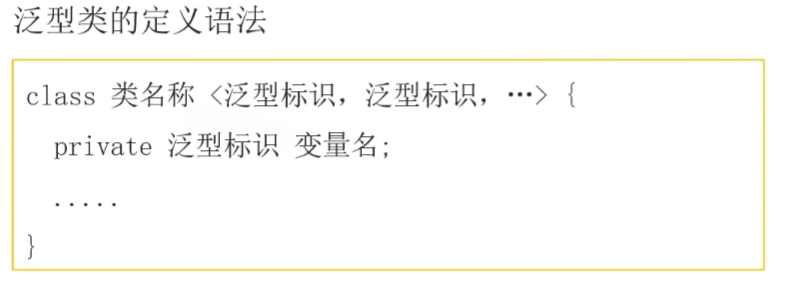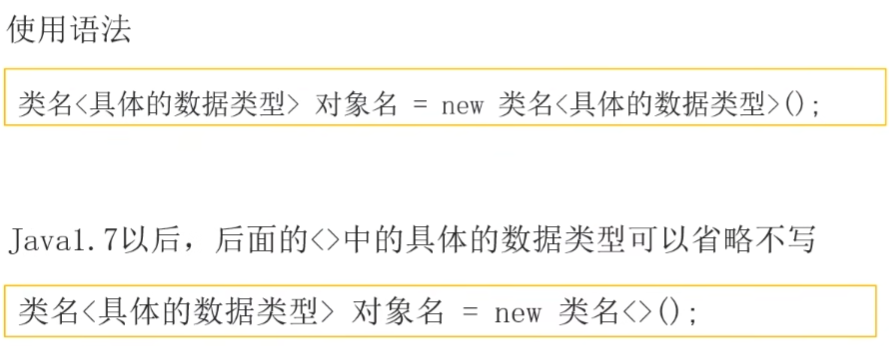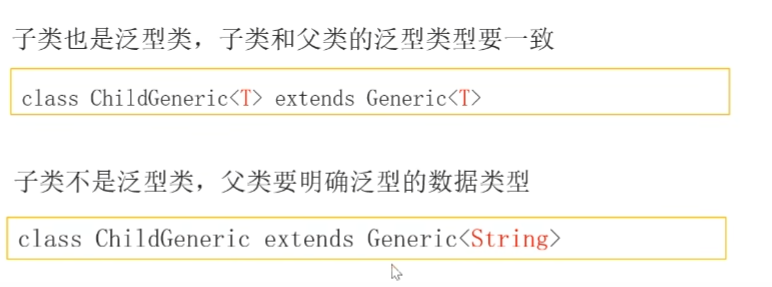泛型
一. 泛型类、接口
1. 泛型类定义与使用


查看代码
// <T> 是泛型标识, 相当于 类型形参
// 在外部使用类的时候指定
class Generic<T> {
private T val;
public Generic(T val) {
this.val = val;
}
public T getVal() {
return val;
}
public void setVal(T val) {
this.val = val;
}
}
class Test {
public static void main(String[] args) {
// 这里的 <String> 相当于是实参
Generic<String> stringGeneric = new Generic<>("abc");
System.out.println(stringGeneric.getVal());
Generic<Integer> integerGeneric = new Generic<>(123);
System.out.println(integerGeneric.getVal());
}
}
泛型类注意点
泛型类,如果没有指定具体的数据类型,此时,操作类型是Object
泛型的类型参数只能是类类型,不能是基本数据类型
泛型类型在逻辑上可以看成是多个不同的类型,但实际上都是相同类型
2. 泛型的作用
1. 编译的时候 检查类型
2. 帮助进行类型转换
查看代码
// 泛型类
class MyArray<T> {
public Object[] array = new Object[10];
public void setValue(int pos,T val) {
array[pos] = val;
}
public T getValue(int pos) {
return (T) array[pos];
}
}
class Test {
public static void main(String[] args) {
MyArray<String> myArray = new MyArray<>();
// 泛型的作用1: 编译的时候 检查类型
// myArray.setValue(1,1); // 报错 !
myArray.setValue(0,"abc");
// 泛型的作用2: 帮助进行类型转换
String str = myArray.getValue(0); // 不需要强转
System.out.println(str);
}
}
3. 泛型类的继承

查看代码
package Generics;
//父类
class Parent<E> {
private E value;
public E getValue() {
return value;
}
public void setValue(E value) {
this.value = value;
}
}
/**
* 泛型类派生子类,子类也是泛型类,那么子类的泛型标识要和父类一致。
* @param <T>
*/
// 子类ChildFirst会把 T类型 当做参数, 传递给父类Parent
// Parent 只有与子类有相同的泛型标识, 才能接收子类传递过来的参数
class ChildFirst<T> extends Parent<T> {
@Override
public T getValue() {
return super.getValue();
}
}
class Test4 {
public static void main(String[] args) {
ChildFirst<String> childFirst = new ChildFirst<>();
childFirst.setValue("abc");
String str = childFirst.getValue();
System.out.println(str);
}
}
查看代码
package Generics.demo2;
class Parent<E> {
private E value;
public E getValue() {
return value;
}
public void setValue(E value) {
this.value = value;
}
}
// 因为子类没泛型标识, 没办法传递类型给父类
// 所以, 父类要明确数据类型
class ChildSecond extends Parent<Integer> {
@Override
public Integer getValue() {
return super.getValue();
}
@Override
public void setValue(Integer value) {
super.setValue(value);
}
}
class Test {
public static void main(String[] args) {
ChildSecond childSecond = new ChildSecond();
childSecond.setValue(123);
System.out.println(childSecond.getValue());
}
}
4. 泛型接口
实现泛型接口的类,不是泛型类,需要明确实现泛型接口的数据类型
查看代码
interface Generator<T> {
T getKey();
}
/**
* 实现泛型接口的类,不是泛型类,需要明确实现泛型接口的数据类型。
*/
class Apple implements Generator<String> {
@Override
public String getKey() {
return "hello generic";
}
}
class Test {
public static void main(String[] args) {
Apple apple = new Apple();
System.out.println(apple.getKey());
}
}
泛型类实现泛型接口, 要保证实现接口的泛型类泛型标识,包含泛型接口的泛型标识
查看代码
package Generics.demo2;
interface Generator<T> {
T getKey();
}
// 泛型类实现泛型接口
// 要保证实现接口的泛型类, <T,E> 泛型标识 包含 泛型接口的泛型标识 <T>
class Pair<T,E> implements Generator<T> {
private T key;
private E value;
public Pair(T key, E value) {
this.key = key;
this.value = value;
}
@Override
public T getKey() {
return key;
}
public E getValue() {
return value;
}
}
class Test {
public static void main(String[] args) {
Pair<String,Integer> pair = new Pair<>("num",100);
System.out.println( pair.getKey() );
System.out.println( pair.getValue() );
}
}
二. 泛型的上界

class MyArray<T extends Number> {
public Object[] array = new Object[10];
public void setValue(int pos,T val) {
array[pos] = val;
}
public T getValue(int pos) {
return (T) array[pos];
}
}
class Test {
public static void main(String[] args) {
// 传入的数据类型必须是 Number类型本身 或者子类
// 报错 !
MyArray<String> myArray = new MyArray<>();
myArray.setValue(0,"abc");
MyArray<Integer> myArray1 = new MyArray<>();
myArray1.setValue(1,1);
}
}
// <T extends Comparable<T>> 表示
// 传入的数据类型 必须实现 Comparable接口
class Alg<T extends Comparable<T>> {
public T findMaxVal(T[] array) {
T max = array[0];
for (int i = 1; i < array.length; i++) {
if(array[i].compareTo(max) > 0) {
max = array[i];
}
}
return max;
}
}
class Test {
public static void main(String[] args) {
Integer[] array = {1,4,3,8,7,5};
Alg<Integer> alg = new Alg<>();
System.out.println(alg.findMaxVal(array));
}
}
三. 泛型方法
class Alg3 {
// 泛型方法
public static <T extends Comparable<T>> T findMaxVal(T[] array) {
T max = array[0];
for (int i = 1; i < array.length; i++) {
if(array[i].compareTo(max) > 0) {
max = array[i];
}
}
return max;
}
}
class Test {
public static void main(String[] args) {
Integer[] array = {1, 4, 3, 8, 7, 5};
System.out.println(Alg3.<Integer>findMaxVal(array));
System.out.println(Alg3.findMaxVal(array));
}
}
四. 类型通配符
1. 通配符
查看代码
package Generics.demo2;
import java.util.Objects;
class Box<E> {
E val;
public E getVal() {
return val;
}
public void setVal(E val) {
this.val = val;
}
}
class Test {
// 不能传入box2, 因为box2指定的类型为Integer
/* public static void print(Box<Number> box) {
System.out.println(box.getVal());
}*/
// 类型通配符
// ? 表示任意类型实参 ex: Number,Integer
// 一定要注意区分 ? 表示任意类型 实参, 而不是形参 T,K,V
public static void print(Box<?> box) {
System.out.println(box.getVal());
}
public static void main(String[] args) {
Box<Number> box1 = new Box<>();
box1.setVal(1);
print(box1);
Box<Integer> box2 = new Box<>();
box2.setVal(2);
print(box2);
}
}
2. 类型通配符的上限
查看代码
package Generics.demo2;
class Box<E> {
E val;
public E getVal() {
return val;
}
public void setVal(E val) {
this.val = val;
}
}
class Test {
// <? extends Number> 表示 传入实参类型, 是 Number本身 或者 Number子类
public static void print(Box<? extends Number> box) {
System.out.println(box.getVal());
}
public static void main(String[] args) {
Box<Number> box1 = new Box<>();
box1.setVal(1);
print(box1);
Box<Integer> box2 = new Box<>();
box2.setVal(2);
print(box2);
}
}
3. 通配符的下限
查看代码
package Generics.demo2;
class Box<E> {
E val;
public E getVal() {
return val;
}
public void setVal(E val) {
this.val = val;
}
}
class Test {
// <? super Integer> 表示 传入实参类型, 是 Integer 或者 Integer 父类
public static void print(Box<? super Integer> box) {
System.out.println(box.getVal());
}
public static void main(String[] args) {
Box<Number> box1 = new Box<>();
box1.setVal(1);
print(box1);
Box<Integer> box2 = new Box<>();
box2.setVal(2);
print(box2);
}
}





 浙公网安备 33010602011771号
浙公网安备 33010602011771号